2018 MERCEDES-BENZ CLA warning
[x] Cancel search: warningPage 300 of 326
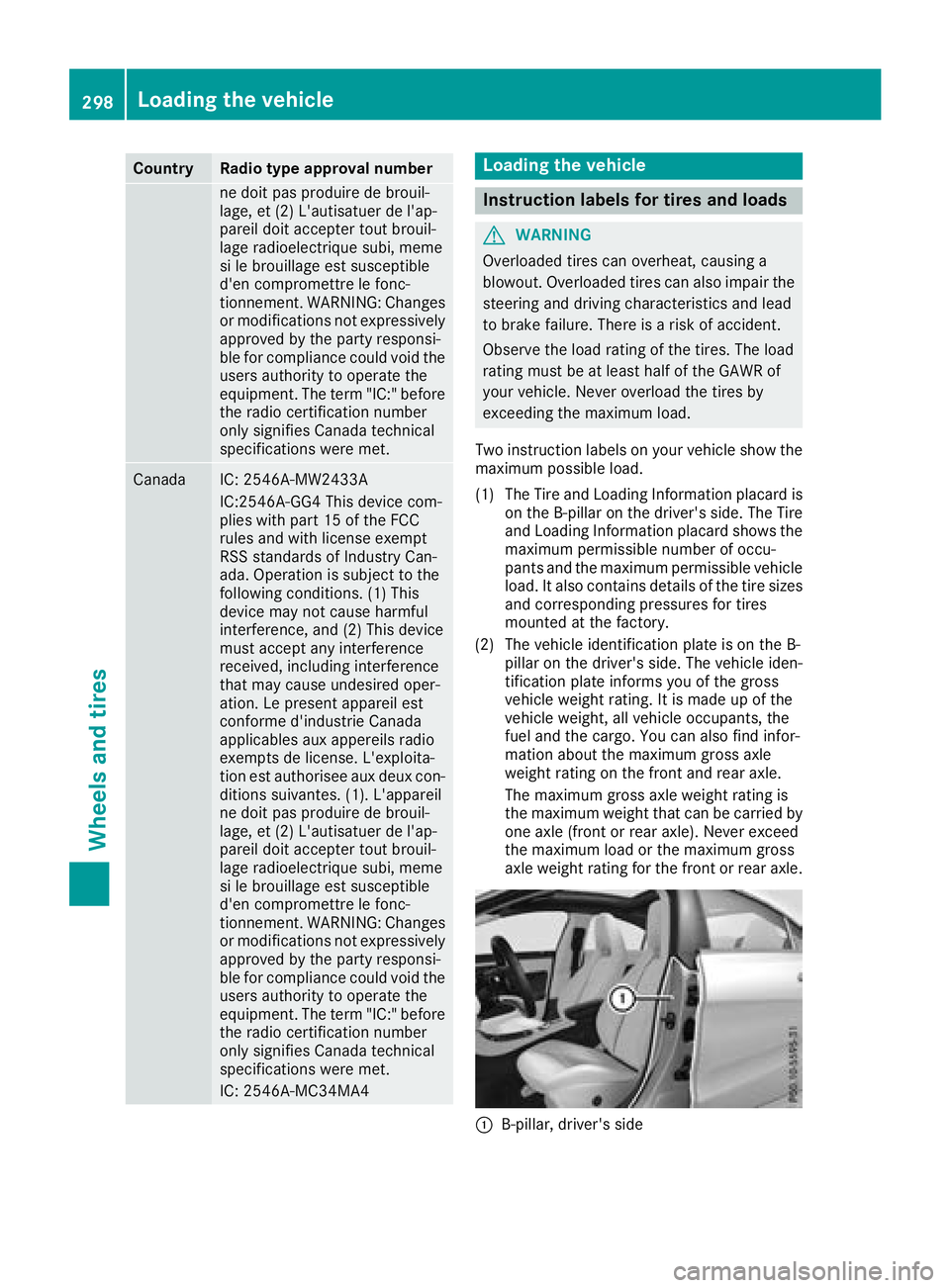
Country Radio type approval number
ne doit pas produire de brouil-
lage, et (2) L'autisatuer de l'ap-
pareil doit accepter tout brouil-
lage radioelectrique subi, meme
si le brouillage est susceptible
d'en compromettre le fonc-
tionnement. WARNING: Changes
or modifications not expressively
approved by th ep art yr esponsi-
ble for compliance could void the
users authorit yt oo perate the
equipment .T he ter m" IC: "b efore
th er adio certification number
onl ys ignifies Canada technical
specifications were met.
Canada IC: 2546A-MW2433A
IC:2546A-GG4 This devic ec om-
plies with part 15 of th eF CC
rules and with licens ee xempt
RSS standards of Industry Can-
ada. Operatio niss ubject to the
following conditions. (1) This
devic em ay not cause harmful
interference, and (2) This device
must accept any interference
received ,i ncludin gi nterference
that may cause undesire do per-
ation. Le present appareil est
conforme d'industrie Canada
applicables aux appereils radio
exempt sdel icense. L'exploita-
tio ne st authorisee aux deux con-
dition ss uivantes .( 1). L'appareil
ne doit pas produire de brouil-
lage, et (2) L'autisatuer de l'ap-
pareil doit accepter tout brouil-
lage radioelectrique subi, meme
si le brouillage est susceptible
d'en compromettre le fonc-
tionnement. WARNING: Changes
or modifications not expressively
approved by th ep art yr esponsi-
ble for compliance could void the
users authorit yt oo perate the
equipment .T he ter m" IC: "b efore
th er adio certification number
onl ys ignifies Canada technical
specifications were met.
IC: 2546A-MC34MA4 Loading th ev ehicle
Instruction labels for tires and loads
G WARNING
Overloade dt ires can overheat ,c ausing a
blowout .O verloade dt ires can also impair the
steerin ga nd driving characteristic sa nd lead
to brak ef ailure. Ther eisar isk of accident.
Observe th el oad rating of th et ires. The load
rating must be at least half of th eG AWR of
your vehicle .N ever overload th et ires by
exceedin gt he maximum load.
Two instruction labels on your vehicle show the
maximum possible load.
(1) The Tire and Loadin gI nf ormation placar di s
on th eB -p illar on th ed river' ss ide. The Tire
and Loadin gI nf ormation placar ds hows the
maximum permissible number of occu-
pant sa nd th em aximum permissible vehicle
load. It also contain sd etails of th et ir es izes
and corresponding pressures for tires
mounted at th ef actory.
(2) The vehicle identification plat eisont he B-
pillar on th ed river' ss ide. The vehicle iden-
tification plat ei nform sy ou of th eg ross
vehicle weight rating .Itism ade up of the
vehicle weight ,a ll vehicle occupants, the
fuel and th ec argo. You can also fin di nfor-
mation about th em aximum gross axle
weight rating on th ef ront and rear axle.
The maximum gross axle weight rating is
th em aximum weight that can be carried by
one axle (front or rear axle) .N ever exceed
th em aximum load or th em aximum gross
axle weight rating for th ef ront or rear axle.
�C
B-pillar ,d river' ss ide298
Loading th ev ehicle
Wheels and tires
Page 304 of 326
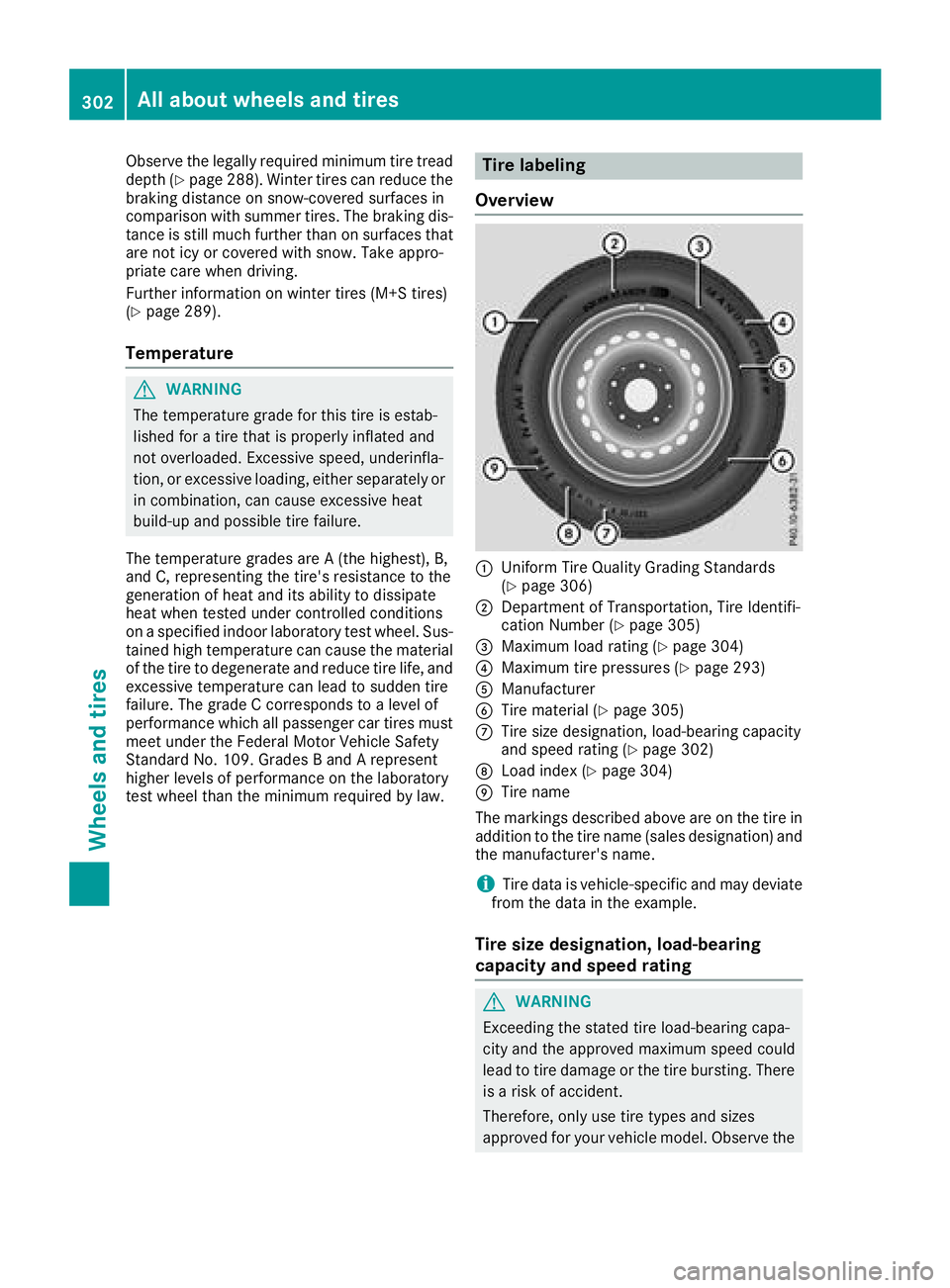
Observe the legally required minimum tire tread
depth ( Y
page 288). Winter tires can reduce the
braking distance on snow-covered surfaces in
comparison with summer tires. The braking dis-
tance is still much further than on surfaces that
are not icy or covered with snow. Take appro-
priate care when driving.
Further information on winter tires (M+S tires)
( Y
page 289).
Temperature
G WARNING
The temperature grade for this tire is estab-
lished for at ire that is properly inflated and
not overloaded .E xcessive speed, underinfla-
tion, or excessive loading, either separately or
in combination, can cause excessive heat
build-up and possible tire failure.
The temperature grades are A( the highest), B,
and C, representing the tire's resistance to the
generation of heat and its ability to dissipate
heat when tested under controlled conditions
on as pecified indoor laboratory test wheel. Sus-
tained high temperature can cause the material
of the tire to degenerate and reduce tire life, and
excessive temperature can lead to sudden tire
failure. The grade Cc orresponds to al evel of
performance which all passenger car tires must
meet under the Federal Motor Vehicle Safety
Standard No. 109. Grades Ba nd Ar epresent
higher levels of performance on the laboratory
test wheel than the minimum required by law. Tire labeling
Overview
�C
Uniform Tire Quality Grading Standards
( Y
page 306)�D
Department of Transportation, Tire Identifi-
cation Number ( Y
page 305)�
Page 310 of 326
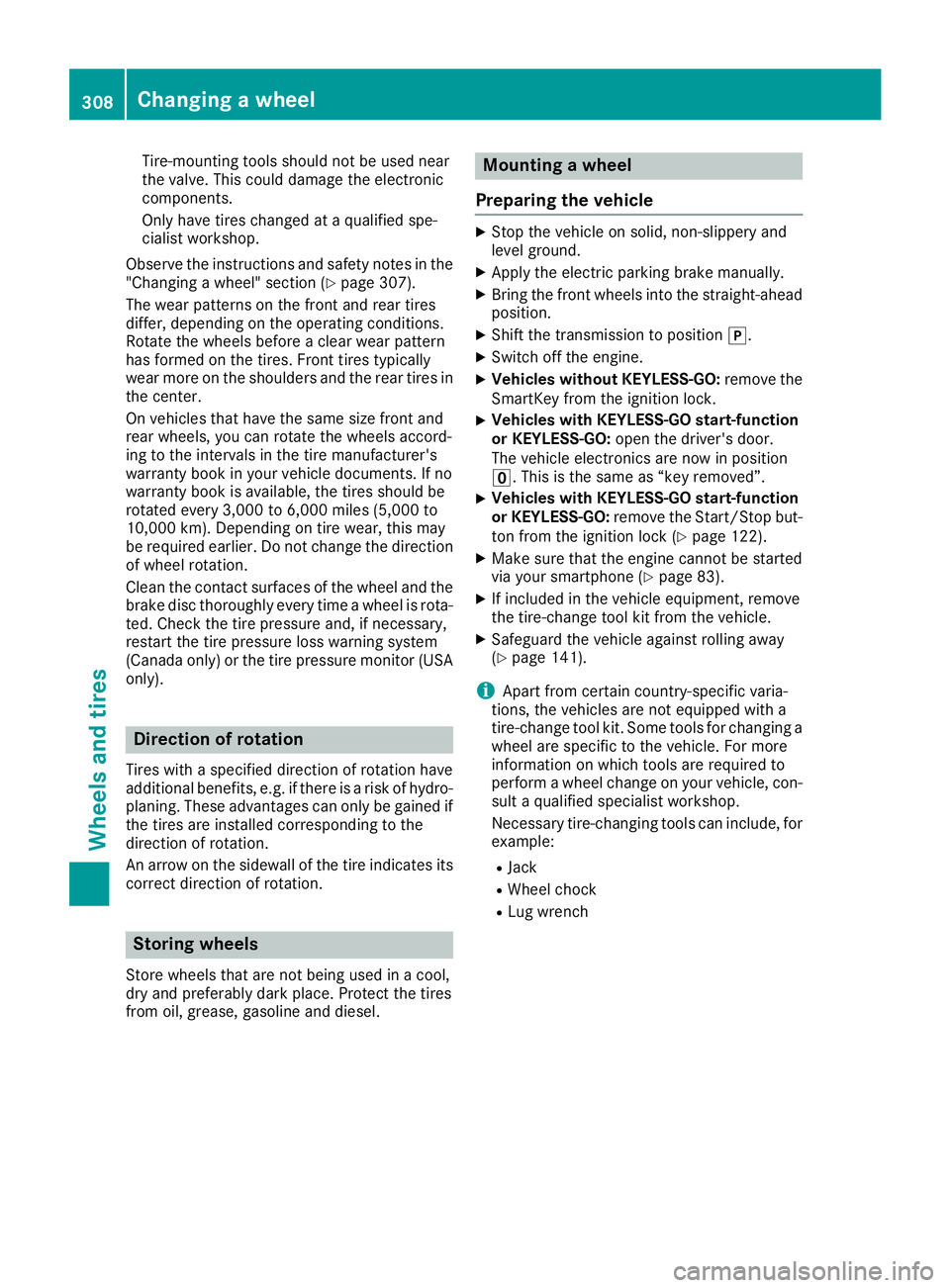
Tire-mounting tools should not be used near
the valve. This could damage the electronic
components.
Only have tires changed at aq ualified spe-
cialist workshop.
Observe the instructions and safety notes in the
"Changing aw heel" section ( Y
page 307).
The wear pattern sont he front and rear tires
differ, depending on the operating conditions.
Rotate the wheels before ac lear wear pattern
has formed on the tires. Fron tt ires typically
wear more on the shoulders and the rear tires in
the center.
On vehicles that have the same size front and
rear wheels, you can rotat et he wheels accord-
ing to the intervals in the tire manufacturer's
warranty book in your vehicle documents. If no
warranty book is available, the tires should be
rotated every 3,000 to 6,000 miles (5,000 to
10,00 0k m) .D ependin gont ire wear, this may
be required earlier. Do not change the direction
of wheel rotation.
Clean the contact surfaces of the wheel and the
brake disc thoroughly every time aw heel is rota-
ted. Check the tire pressure and, if necessary,
restart the tire pressure loss warning system
(Canada only) or the tire pressure monitor (USA
only).
Direction of rotation Tires with as pecified direction of rotation have
additional benefits ,e .g. if there is ar isk of hydro-
planing. These advantages can only be gained if
the tires are installed corresponding to the
direction of rotation.
An arrow on the sidewall of the tire indicates its
correc td irection of rotation.
Storing wheels Stor ew heels that are not being used in ac ool,
dry and preferably dark place. Protec tt he tires
from oil, grease, gasoline and diesel. Mounting aw heel
Preparing the vehicle X
Stop the vehicle on solid, non-slippery and
level ground. X
Apply the electric parking brake manually. X
Bring the front wheels into the straight-ahead
position. X
Shift the transmission to position �] .X
Switch off the engine. X
Vehicles without KEYLESS-GO: remove the
SmartKey from the ignition lock. X
Vehicles with KEYLESS-GO start-function
or KEYLESS-GO: open the driver's door.
The vehicle electronics are now in position
�
Page 313 of 326
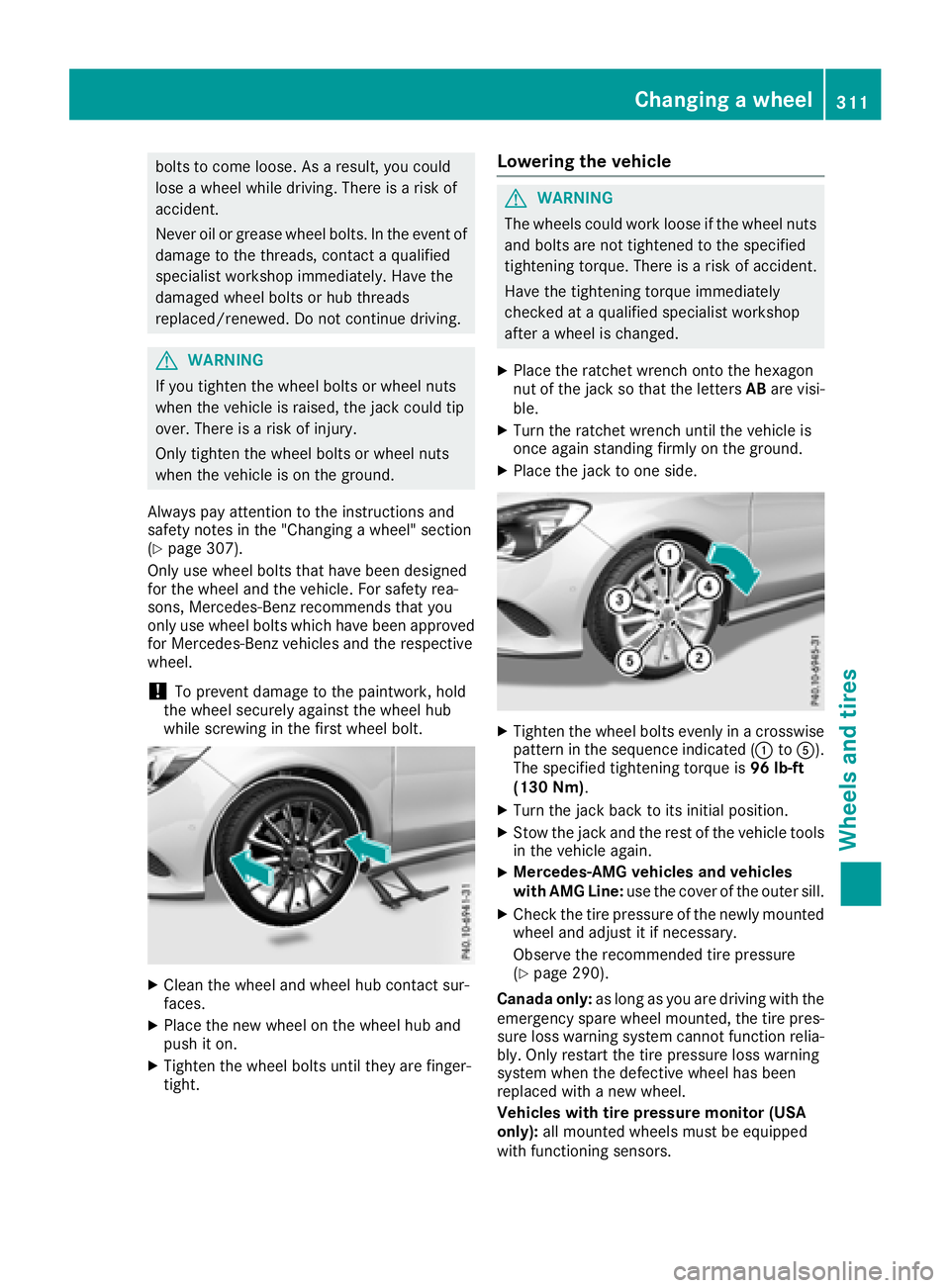
bolts to come loose. As ar esult, you could
lose aw heel while driving .T here is ar isk of
accident.
Never oil or grease wheel bolts. In the event of
damage to the threads, contact aq ualified
specialist workshop immediately. Have the
damaged wheel bolts or hub threads
replaced/renewed. Do not continue driving.
G WARNING
If you tighten the wheel bolts or wheel nuts
when the vehicle is raised, the jack could tip
over. There is ar isk of injury.
Only tighten the wheel bolts or wheel nuts
when the vehicle is on the ground.
Always pay attention to the instructions and
safety notes in the "Changing aw heel" section
( Y
page 307).
Only use wheel bolts that have been designed
for the wheel and the vehicle. For safety rea-
sons, Mercedes-Benz recommends that you
only use wheel bolts which have been approved
for Mercedes-Benz vehicles and the respective
wheel.
! To preven td amage to the paintwork, hold
the wheel securely against the wheel hub
while screwin gint he first wheel bolt.
X
Clean the wheel and wheel hub contact sur-
faces. X
Place the new wheel on the wheel hub and
push it on. X
Tighten the wheel bolts until they are finger-
tight. Lowering the vehicle
G WARNING
The wheels could work loose if the wheel nuts
and bolts are not tightened to the specified
tightenin gt orque. There is ar isk of accident.
Have the tightenin gt orque immediately
checked at aq ualified specialist workshop
after aw heel is changed. X
Place the ratchet wrenc ho nt ot he hexagon
nut of the jack so that the letters AB are visi-
ble. X
Turn the ratchet wrenc hu ntil the vehicle is
onc ea gain standing firmly on the ground. X
Place the jack to one side.
X
Tighten the wheel bolts evenly in ac rosswise
pattern in the sequence indicated ( �C to �
Page 318 of 326
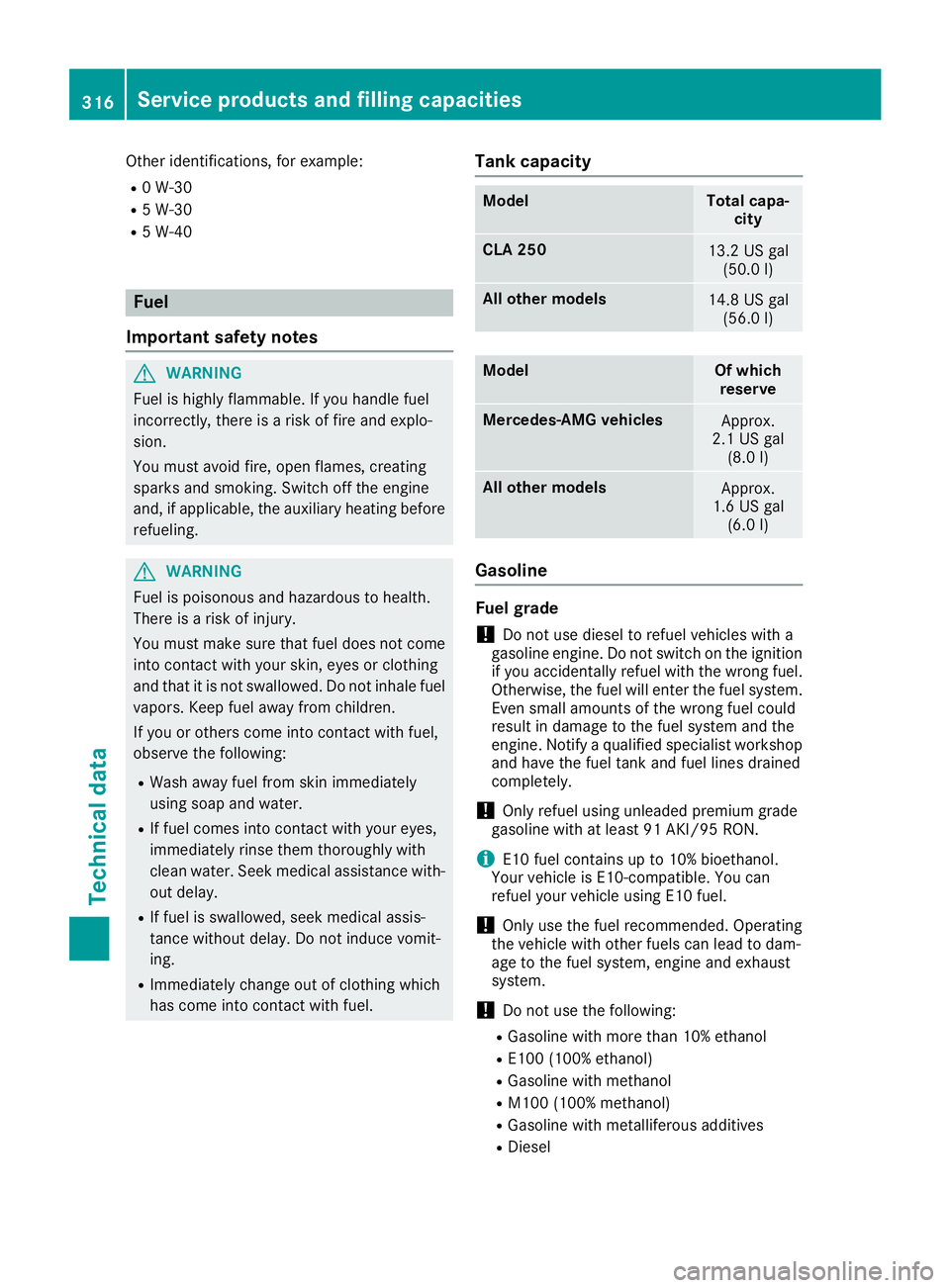
Other identifications, for example: R
0W -30R
5W -30R
5W -40
Fuel
Important safety notes
G WARNING
Fuel is highly flammable. If you handle fuel
incorrectly, there is ar isk of fire and explo-
sion.
You must avoid fire, open flames, creating
sparks and smoking. Switch off the engine
and, if applicable, the auxiliary heating before
refueling.
G WARNING
Fuel is poisonous and hazardous to health.
There is ar isk of injury.
You must make sure that fuel does not come
into contact with your skin, eyes or clothing
and that it is not swallowed. Do not inhale fuel
vapors. Keep fuel awa yf rom children.
If you or others come into contact with fuel,
observe the following: R
Wash awa yf uel from skin immediately
using soap and water. R
If fuel comes into contact with your eyes,
immediately rinse them thoroughly with
clean water. Seek medical assistance with-
out delay. R
If fuel is swallowed, seek medical assis-
tance without delay .Don ot induce vomit-
ing. R
Immediately change out of clothing which
has come into contact with fuel. Tank capacity Model Total capa-
city
CLA 250
13.2 US gal
(50.0 l)
Al lo th er models
14.8 US gal
(56.0 l)
Model Of which
reserve
Mercedes ‑ AM Gv ehicles
Approx.
2.1 US gal
(8.0 l)
All other models
Approx.
1.6 US gal
(6.0 l)
Gasoline
Fuel grade
! Do not use diesel to refue lv ehicles with a
gasoline engine. Do not switch on the ignition
if you accidentally refue lw ith the wrong fuel.
Otherwise, the fuel wil le nter the fuel system.
Even smal la mounts of the wrong fuel could
resul tind amage to the fuel system and the
engine. Notify aq ualified specialist workshop
and have the fuel tank and fuel lines drained
completely.
! Only refue lu sing unleaded premium grade
gasoline with at least 91 AKI/95 RON.
i E10 fuel contains up to 10% bioethanol.
You rv ehicl eisE 10-compatible. You can
refue ly ou rv ehicl eu sing E10 fuel.
! Only use the fuel recommended. Operating
the vehicl ew ith other fuel sc an lea dtod am-
age to the fuel system, engine and exhaust
system.
! Do not use the following: R
Gasoline with more than 10% ethanol R
E100 (1 00% ethanol) R
Gasoline with methanol R
M100 (1 00% methanol) R
Gasoline with metalliferous additives R
Diesel316
Service products and fillin gc apacities
Technical data
Page 320 of 326
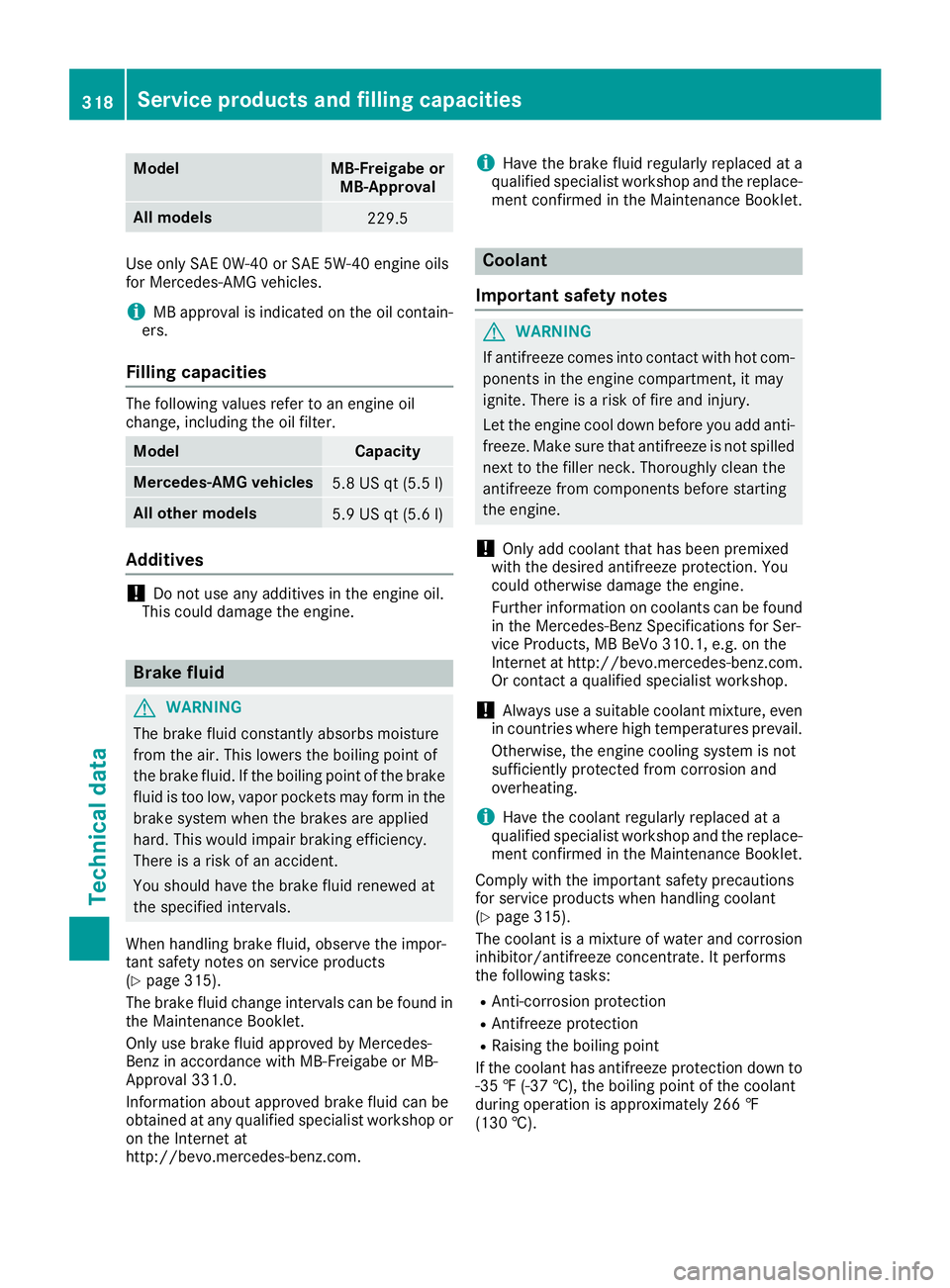
Model MB-Freigabe or
MB-Approval
All models
229.5
Use only SAE 0W-40 or SAE 5W-40 engine oils
for Mercedes-AMG vehicles.
i MB approval is indicated on the oil contain-
ers.
Fillin gc apacitiesThe following values refer to an engine oil
change, including the oil filter.
Model Capacity
Mercedes ‑ AM Gv ehicles
5.8 US qt (5.5 l)
All other models
5.9 US qt (5.6 l)
Additives
! Do not use any additives in the engine oil.
This could damage the engine.
Brake fluid
G WARNING
The brake flui dc onstantly absorbs moisture
from the air. This lowers the boiling point of
the brake fluid. If the boiling point of the brake
flui dist oo low ,v apo rp ockets may form in the
brake system when the brakes are applied
hard. This would impair braking efficiency.
There is ar isk of an accident.
You should have the brake flui dr enewe da t
the specified intervals.
When handling brake fluid, observe the impor-
tant safety notes on service products
( Y
pag e3 15).
The brake flui dc hange interval sc an be found in
the Maintenance Booklet.
Only use brake flui da pproved by Mercedes-
Benz in accordance with MB-Freigabe or MB-
Approva l3 31.0.
Information about approved brake flui dc an be
obtained at any qualified specialist workshop or
on the Internet at
http://bevo.mercedes-benz.com. i Have the brake flui dr egularl yr eplaced at a
qualified specialist workshop and the replace-
ment confirmed in the Maintenance Booklet.
Coolant
Important safety notes
G WARNING
If antifreeze comes into contact with hot com-
ponents in the engine compartment, it may
ignite. There is ar isk of fire and injury.
Let the engine cool down before you add anti-
freeze. Make sure that antifreeze is not spilled
next to the filler neck. Thoroughly clea nt he
antifreeze from components before starting
the engine.
! Only add coolant that has been premixed
with the desired antifreeze protection. You
coul do therwise damage the engine.
Further information on coolants can be found
in the Mercedes-Benz Specifications for Ser-
vice Products, MB BeVo 310.1, e.g. on the
Internet at http://bevo.mercedes-benz.com.
Or contact aq ualified specialist workshop.
! Always use as uitable coolant mixture, even
in countries where high temperatures prevail.
Otherwise, the engine cooling system is not
sufficiently protected from corrosio na nd
overheating.
i Have the coolant regularl yr eplaced at a
qualified specialist workshop and the replace-
ment confirmed in the Maintenance Booklet.
Comply with the important safety precautions
for service products when handling coolant
( Y
pag e3 15).
The coolant is am ixture of water and corrosion
inhibitor/antifreeze concentrate. It performs
the following tasks: R
Anti-corrosion protection R
Antifreeze protection R
Raising the boiling point
If the coolant has antifreeze protection down to
-35 ‡( -37 †), the boiling point of the coolant
during operation is approximatel y2 66 ‡
(130 †).318
Servic ep roducts and filling capacities
Technical data
Page 321 of 326
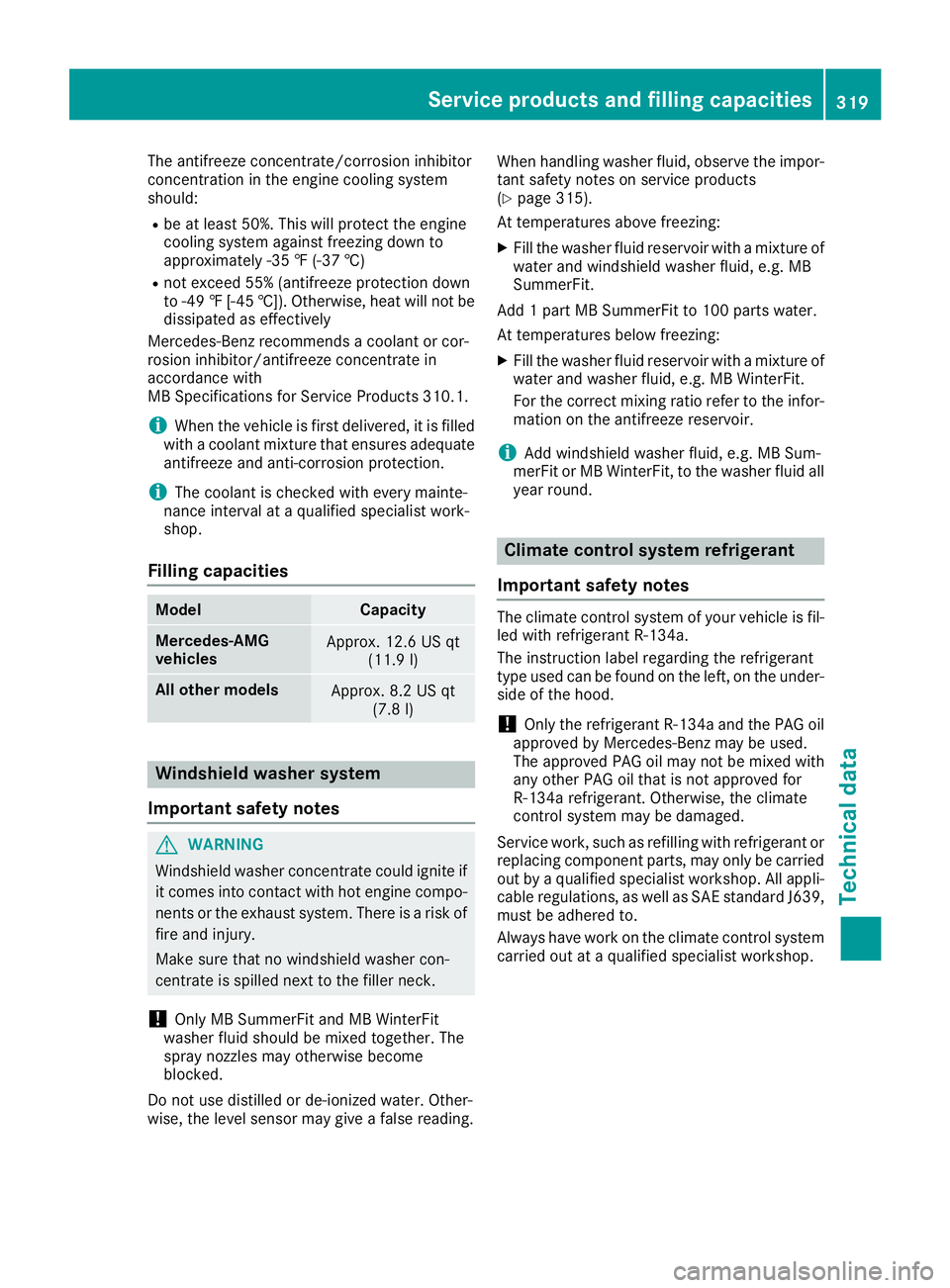
The antifreeze concentrate/corrosion inhibitor
concentration in the engine cooling system
should: R
be at least 50%. This will protec tt he engine
cooling system against freezin gd own to
approximately -35 ‡( -37 †)R
not exceed 55% (antifreez ep rotection down
to -49 ‡[ -45 †]) .O th erwise ,h ea tw ill no tb e
dissipated as effectively
Mercedes-Ben zr ecommends ac oo lan torc or -
rosio ni nh ibitor/antifreez ec oncentrat ei n
accordance wit h
MB Specification sf or Servic eP ro ducts 310. 1.
i When the vehicle is first delivered, it is filled
with ac oolant mixture that ensures adequate
antifreeze and anti-corrosion protection.
i The coolant is checked with every mainte-
nanc ei nterval at aq ualified specialist work-
shop.
Filling capacities Model Capacity
Mercedes ‑ AMG
vehicles Approx .1 2. 6USq t
(11. 9l )
Al lo th er models
Approx. 8.2 US qt
(7.8 l)
Windshield washe rs ystem
Important safety notes
G WARNING
Windshiel dw as her concentrate coul di gnite if
it comes into contact with hot engine compo-
nents or the exhaust system .T here is ar isk of
fire and injury.
Make sure that no windshield washer con-
centrate is spilled next to the filler neck.
! Only MB SummerFi ta nd MB WinterFit
washer flui ds hould be mixed together. The
spra yn ozzles may otherwise become
blocked.
Do not use distille dord e-ionized water. Other-
wise, the leve ls ensor may give af als er eading. When handling washer fluid, observe the impor-
tant safety notes on service products
( Y
pag e3 15).
At temperatures above freezing: X
Fill the washer flui dr eservoir with am ixture of
water and windshield washer fluid, e.g. MB
SummerFit.
Add 1p art MB SummerFi tto1 00 parts water.
At temperatures below freezing: X
Fill the washer flui dr eservoir with am ixture of
water and washer fluid, e.g. MB WinterFit.
For the correct mixing ratio refer to the infor-
mation on the antifreeze reservoir.
i Add windshield washer fluid, e.g. MB Sum-
merFit or MB WinterFit, to the washer flui da ll
yea rr ound.
Climate control system refrigerant
Important safety notes The climate control system of you rv ehicl eisf il-
led with refrigerant R ‑ 134a.
The instruction label regarding the refrigerant
type use dc an be found on the left, on the under-
side of the hood.
! Only the refrigerant R ‑ 134a and the PAG oil
approved by Mercedes-Benz may be used.
The approved PAG oil may not be mixed with
any other PAG oil that is not approved for
R-134a refrigerant. Otherwise, the climate
control system may be damaged.
Service work, such as refilling with refrigerant or
replacing component parts, may only be carried
out by aq ualified specialist workshop. All appli-
cabl er egulations, as wel lasS AE standard J639,
must be adhered to.
Always have work on the climate control system
carrie do ut at aq ualified specialist workshop.Service products and filling capacities 319
Technical data Z
Page 322 of 326
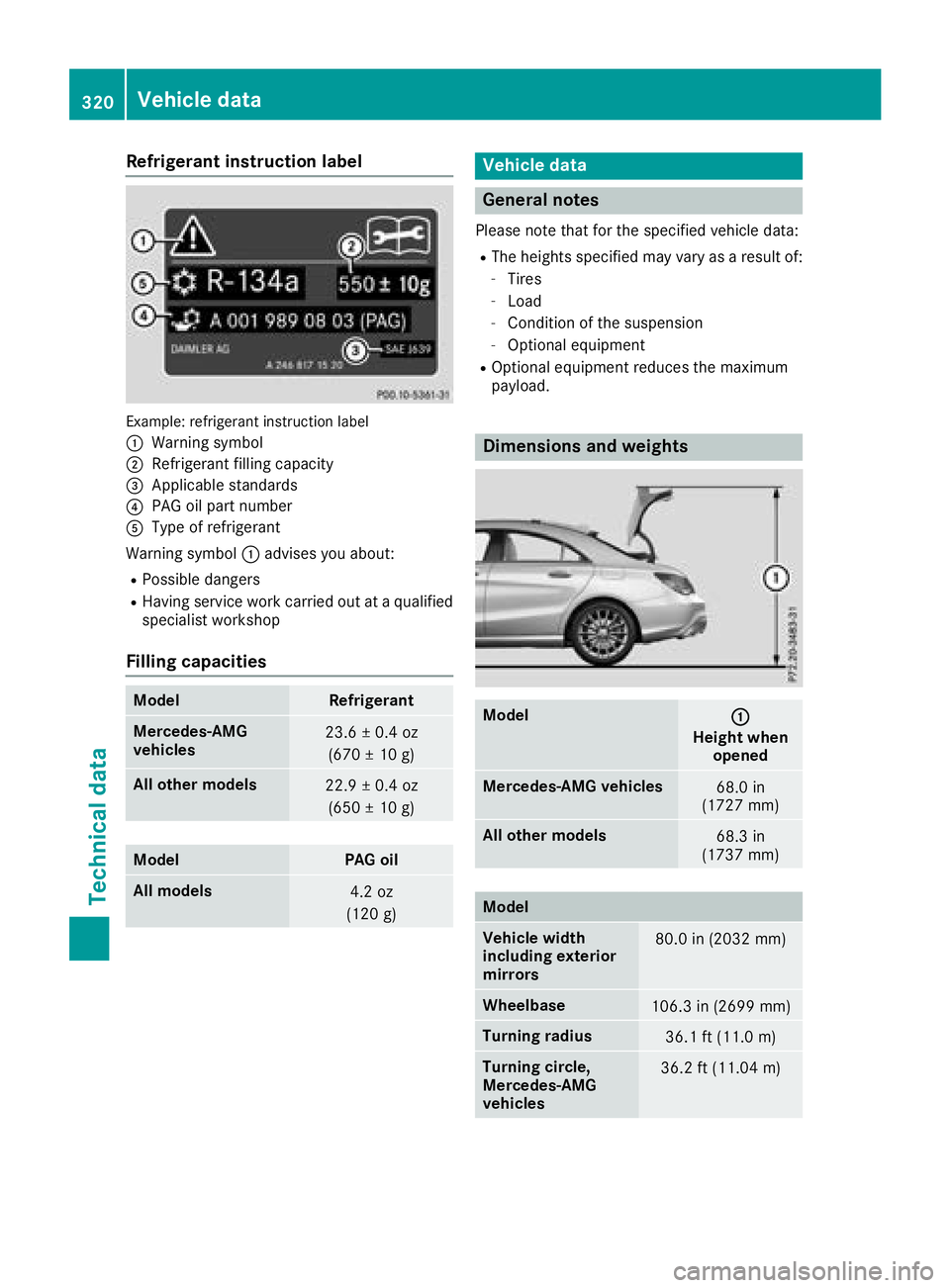
Refrigerant instructio nl abel
Example :r efrigerant instruction label
�C
Warning symbol�D
Refrigerant filling capacity�